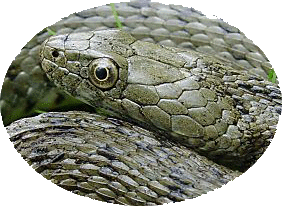
蛇がグルメで ある理由
This forked tongue explains why all these animals are so dainty in their food!

解説:池田光穂
Of course the Vivipara as well as these creatures have this power of perception(indeed, the enjoyment derived from practically all edible dainties takes place while they are being swallowed and is due to the distension of the oesophagus...); but whereas the rest of the animals have the power of perception by taste as well, these are without it quadrupeds, lizards (and serpents too) have two-forked tongue, the tips of which are as fine as hairs. Seals also have a forked tongue. This forked tongue explains why all these animals are so dainty in their food!! (Aristotle, On the Parts of Animals, the Lobe edition , p.393 & 395).
もちろん、胎生動物もこれらの生物もこの知覚力を持っている(実際、ほとんどすべての食用珍味から得られる楽しみは、それ らを飲 み込んでいる間に起こり、食道の膨張によるものだ...)が、他の動物が同様に味による知覚力を持つのに対し、これらはそれを持たない四足動物だ。トカゲ (そして蛇も)は二股(=フォーク状)の舌を持っていて、その先は髪の毛ほど繊細である。アザラシも分かれ目のある舌を持っている。この分かれ目のある舌 のおかげで、これらの動物がみな、食が繊細(=グルマン)というわけだ。
And there is side story of human being... "Tongue bifurcation, splitting or forking, is a type of body modification in which the tongue is cut centrally from its tip to as far back as the underside base, forking the end. Bifid tongue in humans may also be an unintended complication of tongue piercings[1] or a rare congenital malformation associated with maternal diabetes,[2] orofaciodigital syndrome 1,[3] Ellis–Van Creveld syndrome, Goldenhar syndrome, and Klippel–Feil syndrome.[4]"- https://en.wikipedia.org/wiki/Tongue_splitting.
リンク
文献
その他の情報
Copyleft, CC, Mitzub'ixi Quq Chi'j, 1996-2099
アリストテレス、蛇、へび、ありすとてれす、グルメ、ぐるめ、動物部分論、動物誌、目的論、動物学、 古典、古代ギリシャ